Swiss Federal Council on “School Trip” to the University of Bern
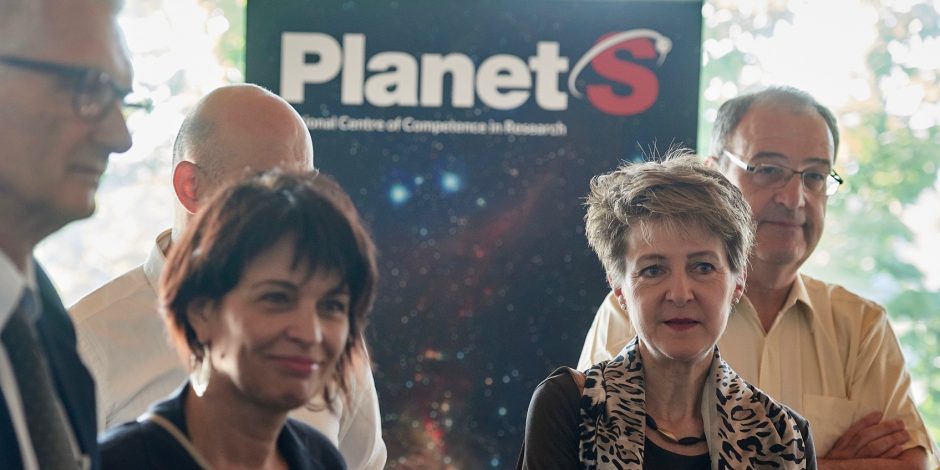
To kick off its annual “school trip” around the country, the Swiss Federal Council paid the Center for Space and Habitability of the University of Bern a visit on July 7th, 2016. The members of government were informed about the important role the university plays in space projects such as ROSINA / Rosetta, ExoMars and CHEOPS.
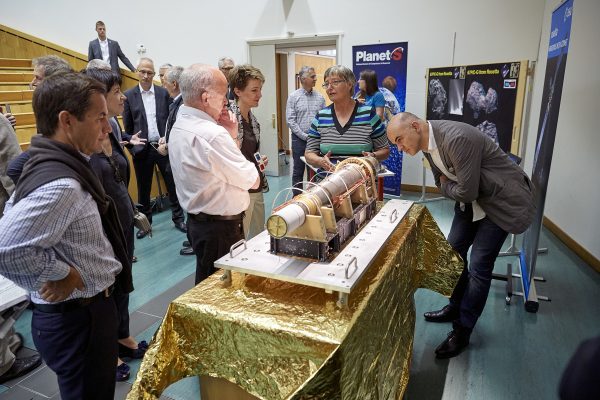
A special seminar for the Swiss Federal Council: Bernese Space Exploration – With the ROSINA-RTOF model Kathrin Altwegg offers insight into their work. © University of Bern / Adrian Moser
“Casual Day”, which was this Thursday, started at 8 am for the Federal Council – for once it did not take place at the Federal Building, but at the annual “school trip” around the country. As a starting point, the Swiss Council chose the Exact Sciences building (ExWi) at the University of Bern, where they were received by the Head of the University and the Director of Education for Canton Bern, Bernhard Pulver. “It is not every day that all seven federal councilors visit the University of Bern,” says Christian Leumann, the designated Rector, with a wink in his welcoming speech.
The University of Bern owes this honor to its space researchers. Then after coffee and croissants, the Swiss Federal Councilors, the Chancellor and both vice Chancellors enjoy a special seminar from Bernese space researchers Willy Benz, Kathrin Altwegg and Nicolas Thomas, all working at the Center for Space and Habitability (CSH). Benz illustrates the important role of the University in international space research. “Here we treat the fundamental questions of mankind,” he says, “How did the Solar System arise? Is the Earth unique? Is there life elsewhere in the Universe?” With obvious pleasure, he reaches a framed razor-thin piece of aluminum foil to the important guests – this is a piece of the solar sail, which was originally developed at the University of Bern for the first Apollo Moon Mission in 1969. At that time, US Astronaut Edwin «Buzz» Aldrin unrolled and placed the sail on the Moon – even before placing the US flag, as Benz reports not without pride, “It was almost a type of Swiss flag on the moon”, that Aldrin installed, as he stepped as second man onto the lunar surface shortly after Neil Armstrong.
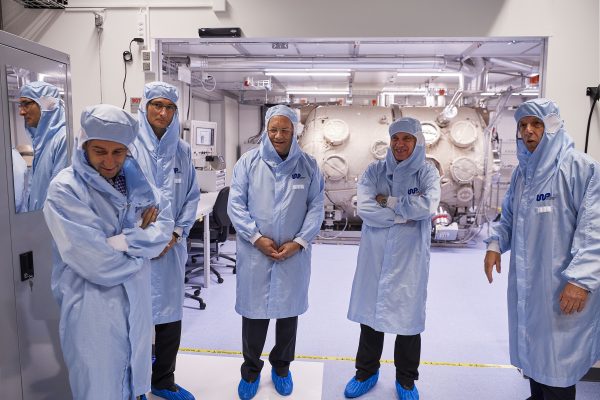
The clean room at ExWi can only be entered wearing protective suits. Pictured above (from left to right): Federal Council Spokesman, André Simonazzi; Director of Education, Bernhard Pulver; President, Johann Schneider-Ammann; Minister of Finance, Ueli Maurer and Professor Willy Benz, CSH. © University of Bern / Adrian Moser
Looking for Earth-like planets
After the introductory talk, the CHEOPS (CHaracterizing ExOPlanet Satellite) labor, which may only be entered wearing protective gear, is of significant interest. In this clean room, employees of CSH assemble the CHEOPS telescope and test it for its suitability for space in a five and a half tones calibration and vacuum chamber. A person could comfortably sit in the three meter-long and two-meter high cylinder. Considering its size and complexity, this test chamber is unique in Switzerland. It is also the first time that Switzerland is responsible not only for an instrument or parts of it, but for an entire mission, together with the European Space Agency (ESA). The lead of the mission is in the hands of Benz. “The project team is working at top speed”, he says, “The launch of the satellite is scheduled for 2018.” From then on, the space telescope should explore so-called Exo-Planets – “and may be bring us a bit closer to the long-term goal of finding an Earth-like planet.”
In the large lecture hall at ExWi, the members of government survey functional prototypes of the mass spectrometer ROSINA-RTOF and the space camera CaSSIS. Both units were developed and built at the University of Bern. ROSINA is aboard the Rosetta spacecraft, currently orbiting the comet 67P / Churyumov-Gerasimenko, while CaSSIS is part of the ExoMars spacecraft, which is headed towards Mars.
For amusement, Physicist Kathrin Altwegg, Head of the ROSINA team, presents a model comet: It consists of dry ice, dirt – and soy sauce. “For taste?” asks Interior Minister, Alain Berset jokingly. “No, to simulate the organic components of the comet,” answers Altwegg. Justice Minister, Simonetta Sommaruga wants to know if Altwegg thinks there could also theoretically be life on Chury based on the organic molecules recently found by researchers. The Space Research Specialist categorically denies this. It is much too cold on the comet and there is literally not enough energy for life to develop.
“I am proud of the University of Bern”
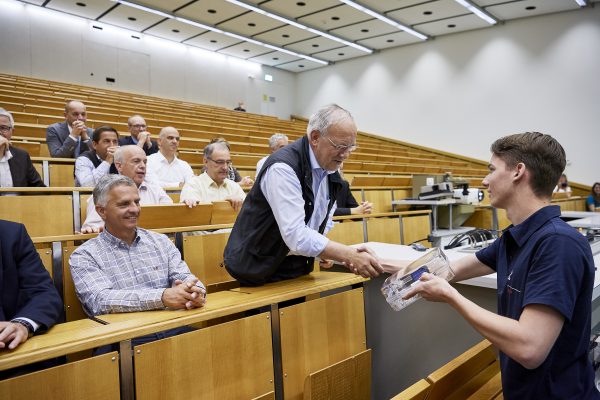
Farewell gift: For the members of the Swiss Federal Council the polytechnician apprentices of the Physics Institute manufactured exclusive models of the space telescope CHEOPS. © University of Bern / Adrian Moser
There are many fundamental questions revolving around the existence of extraterrestrial life. Kathrin Altwegg acknowledges that it is indeed likely that this exists. It is still difficult to track it; not least because no one can say exactly what life really is. For this reason, space researchers, theologians and philosophers are currently debating the nature of life at CSH – Altwegg admits that she is particularly fascinated by the philosophical approach: “For philosophers, life is primarily a concept. If life did not exist, no one could discuss it.”
At exactly 9 o’clock the entertaining seminar has concluded. Before the Federal Councilors, Chancellor and vice Chancellors continue their school trip, the polytechnician apprentices hand them on models of the space telescope CHEOPS as a farewell gift. They manufactured the detailed scale 1:20 models themselves. President Johann Schneider-Ammann thanked the employees of the university for their hospitality and the exciting insights into their work. He concludes, “I am proud of the achievements of the University of Bern!”
Traditional yearly excursion
The day after the last official meeting of the Swiss Federal Government, the Federal Councilors set out on their traditional two-day annual trip. The annual excursion has been carried out every year since 1957. Since 1961, the annual trip takes place in the home canton of the acting Federal President – for the year 2016, this is the Economics Minister, Johann Schneider-Ammann from Langenthal in Canton Bern.
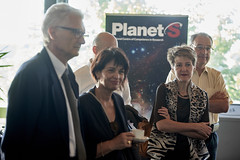

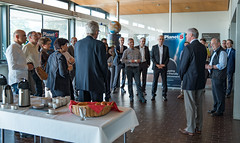
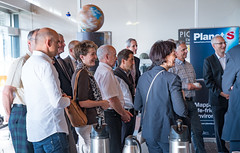

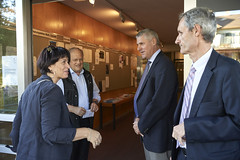
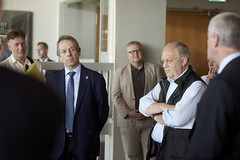
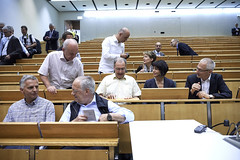
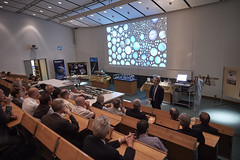
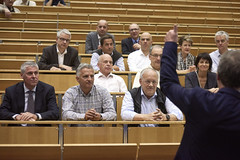

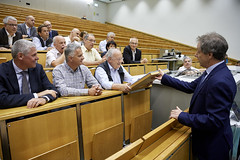
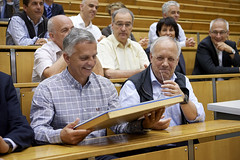

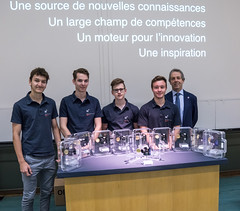
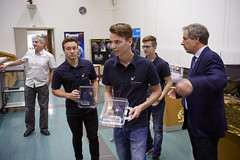
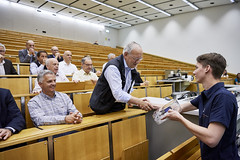
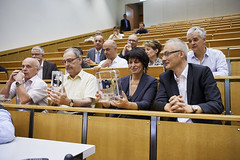
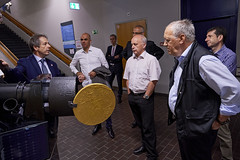
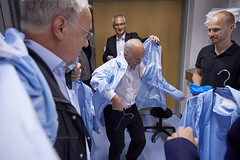
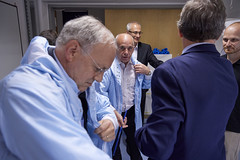

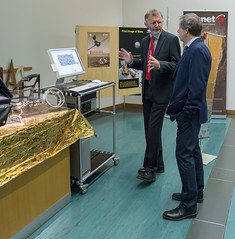
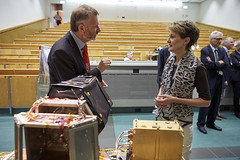
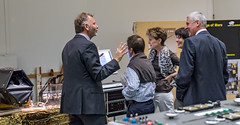
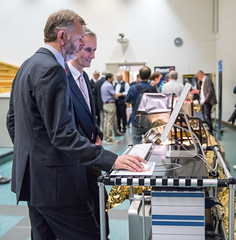

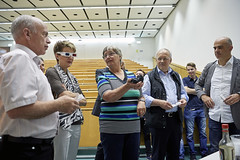
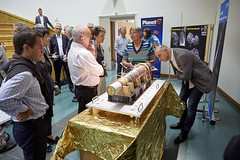
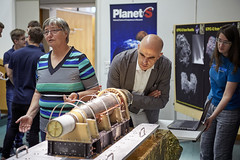
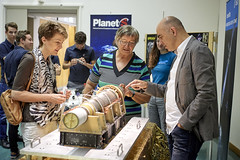
Categories: Internal Newsletter, News

